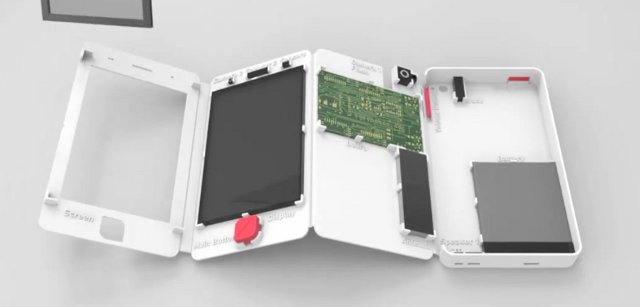The “Smarter Phone“, which is just a concept right now, would allow users to easily upgrade or repair it by changing key modules. Your phone currently has a 5MP camera, and you’ll like to upgrade for a 12MP. No problem, just replace the camera module. We’re now in 2016. The quad core processor in your smartphone feels really slow, and memory is tight, so you’d like to replace it with the latest Exynos 7 20-core processor with extra-large.big.medium.little.tiny processing technology, and finally get 8GB RAM. You can do so by just updating the CPU module, and on and on.
Basically, your smartphone would be just as upgradeable as your PC, which is probably timely since in a couple of years, your phone may become your PC. This concept designed by Bernat Lozano (Product Designer), and Rocío García (Architect & Product Designer), would help save consumers’ money, and reduce e-waste, as they nicely explain in the video below.
It’s an interesting concept, but in reality this may be challenging to implement. First, over the years, standards may change, and you may not be able to get the very latest feature without having to replace the phone. Second, you’ll need compatibility between all those parts, as well as companies and people committed to provide software support for the different modules over several years (e.g. 10 years). The device shown in the video appears to be a bit bulky, but it might be possible to improve it. There are some ribbon cables to connect different modules which are not shown here, and this may also become an issue for end-users has insertion is not always that easy. What do you guys (and girls) think?

Jean-Luc started CNX Software in 2010 as a part-time endeavor, before quitting his job as a software engineering manager, and starting to write daily news, and reviews full time later in 2011.
Support CNX Software! Donate via cryptocurrencies, become a Patron on Patreon, or purchase goods on Amazon or Aliexpress







“Exynos 7 20-core processor with extra-large.big.medium.little.tiny processing technology ” hahahah hilarious naming 😀
IMHO this is not going to work. If you would build it, it would be bulky and expensive, both because of standardized interfaces you would need. And people do not want that.
And after two years, you probably want to replace the CPU, GPU, screen, memory and baseband module. Oh, and the battery of course. So … what’s left? The power adapter?
The comparison with the old-skool desktop is correct: we *used* to put expansion boards in them. But now we buy a laptop with everything on-board.
The thing that this would achieve that I’d be keen to see is driver installs and standard white ROMs. We wouldn’t need the ROM developer community to commit all of their time to just getting the next phone working. They could do something unique with their ROMs instead.
@Sander
This post made it to reddit gadget (http://www.reddit.com/r/gadgets/comments/1f7a7h/the_smarter_phone_is_upgradeable_and_repairable/), and most commenters seem to agree it’s not really feasible or desirable.
I could see this in a very limited form. Power source, Phone, screen, at most. I could really see some kind of reusable power source used across products, once batteries get super long lives or we finally go with liquid fuels for phones (really).
Well, since bar-shaped phones and tablet PCs seem to virtually converge on a few form factors, it wouldn’t come much as a surprise if e.g. some Chinese productors were trying to extend the motherboard form factor concept to such devices, by settling on, say, six different form factors for most devices. Then factories and perhaps even customers could eventually use multiple standard-compliant systems-on-module with multiple envelopes (with different features) and maybe other compatible components.
I think that we as customers should look in that direction.
I work on phones for a living. The way the are inside would have to drastically change. You can’t just change out ram or a processor on a board. Making things that can be swapped out would add a lot to the bulk of the phone. Also most phone are brought on contract for 0-200 dollars. An lcd/glass combo for an S3 is around 250 for a good one. People in the US don’t understand how subsidized their phones are and would probably balk at the cost of replacing individual parts.
the ultimate solution of e-waste is to put them into one united cloud computer center.
@gzmask
How would that work?
@cnxsoft
Your phone would become a simple terminal. All the applications and processing would happen in a data center somewhere.
Return to the mainframe, except the terminals are portable.
@gzmask
@Ron
So you’d get a “dumb” phone just displaying the data rendered on the server, just like a thin client, so all upgrades would in theory be on the server side.
IMHO it’s even more challenging than the “Smarter Phone” concept. First, you’d have to handle network bandwidth and latency issues, and massive infrastructure investments would be required. This would most likely not work with people using prepaid plans due to the monthly data usage, and it does not take into account phone interface upgrades. For example, you can’t simply upgrade Bluetooth 2.1 to Bluetooth 4.0 in the server, same for Wi-Fi 802.11g to 802.11n, or baseband modules, or screen resolution… it requires hardware modifications in the phone.
To me it would just allow for smartphones with lower-end processors (with the same functionality as high-end processors), so I don’t really see how it can help reduce e-Waste, since the phone would likely have to be upgraded anyway.